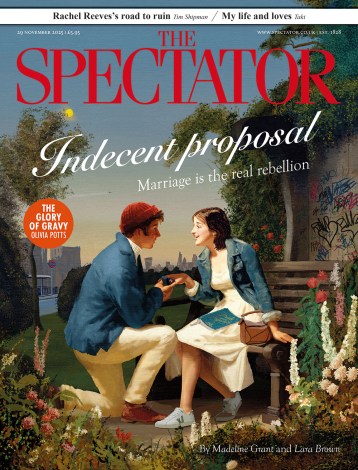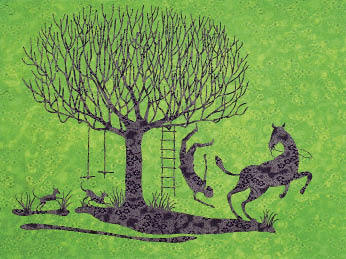Maggi Hambling: Sea Sculpture, Paintings and Etchings
Marlborough Fine Art, 6 Albemarle Street, W1, until 5 June
Stephen Chambers: The Four Corners
Kings Place Gallery, 90 York Way, N1, until 11 June
Ceri Richards: Retrospective
Jonathan Clark & Co., 18 Park Walk, SW10, until 5 June
For the past eight years, the sea has been Maggi Hambling’s principal subject. She draws it regularly, makes portraits of it and now has turned to capturing it in bronze. As Norbert Lynton observed (in another context): ‘The idea of the sea as matter for sculpture should give us pause: not even [Medardo] Rosso, master sculptor of the momentary and the contextual, attempted anything like that.’ Hambling (born 1945) likes a challenge, and, in taking on the wave in solid three-dimensional form, she has certainly set herself that.
The show at the Marlborough consists of a dozen free-standing sculptures of waves curling, rearing, rolling, tossing seaweed and laughing at the moon. The range is aggressive to playful, and the crusted bronze surfaces are pierced with lunar silhouettes or the broken teeth of breakwaters, bedecked with bobbly necklaces of bladderwrack, horripilant with spume and spray. In addition, there are another couple of dozen bronze wall reliefs. Each bronze is a unique cast, and Hambling has been inventive with the polishing and patination to provide a pleasing variety of colour and surface texture. To my mind, the reliefs are the most successful of the sculptures, less confrontational and pugilistic, more relaxed and quietly beguiling in their physical presence.
This is partly to do with the increased abstraction of their language. Freed from the requirement to describe or evoke a wave in three-dimensional form, Hambling can concentrate her considerable energies and invention upon making an image that works as an object of what might be called ‘enhanced linearity’ rather than mass. To some extent, the reliefs are like painting in bronze, though their small size and material density curtail any urge to Baroque excess. The resulting bronze plaques, elegantly finished in golden bronze, black or turquoise, are some of the most beautiful and sensuous works that Hambling has ever made. They mark a substantial new development for this protean artist, and at prices that start at £2,500, they are extremely competitively priced for one-off sculptures.
In the gallery’s end room are Hambling’s new sea etchings, an expectedly strong body of graphic work, of which the turquoise variants are proving especially popular. There are only four wave paintings hung among the sculptures, including a brown March roller that is particularly effective. For those interested in seeing more of her sea paintings, Hambling is also showing new work at the Fitzwilliam Museum (until 18 July). She calls the North Sea ‘the widest of mouths’ as it consumes the coast of Suffolk where she lives, roaring and laughing, but always seductive. Rather like Hambling herself.
Kings Place Gallery is becoming recognised as an alternative exhibiting venue that combines elements of private dealership with corporate space. Just beside King’s Cross Station, and the home of the Guardian and Observer newspapers, as well as a conference centre, concert hall and much more, Kings Place is worth a visit on a number of counts. The gallery is commercially oriented but has access to vast public wall spaces where big paintings may be hung or an extensive exhibition of smaller work may be mounted. Stephen Chambers (born 1960) has chosen to select a mini-retrospective of recent prints for this area, and concentrated his paintings within the gallery space. This solution works well.
His prints benefit from having a lot of space around them. Chambers, a prolific and inventive printmaker, generally makes complex and colourful images that can hold a wall. In his intriguingly popular 2009 series of etchings ‘My Shitty Sisters’, the style is very much like the ink drawings he makes to discover the compositions for his paintings, and the effect is largely monochrome. The paintings orchestrate patterns like music, for Chambers is a master of pictorial design, tricking out his lucid, ludic images with pegs and ladders and matches. (A crossword devotee, he even spells out words in matchsticks.) Pre-eminently, Chambers is unflinching in his dedication to colour, for he makes his chosen hues of orange, red and green seem like newly discovered colours, as if never seen before.
Finally, there’s a highly enjoyable exhibition of work from the estate of Ceri Richards (1903–71) at Jonathan Clark & Co. It’s accompanied by one of the most beautiful catalogues I’ve seen in years, superbly designed and illustrated, with illuminating texts by Richards’s son-in-law, Mel Gooding. The exhibition focuses chiefly on works on paper, with a couple of substantial oil paintings to show the range of this artist’s insufficiently recognised achievement. A powerful draughtsman, Richards used ink in combination with watercolour in countless enlivening ways, exploring the various themes and subjects that preoccupied him: wartime tinplate workers, costermongers, pearly Kings and Queens, the pianist, classical mythology (and particularly the Rape of the Sabines) and the poetry of Dylan Thomas. Richards was a great nature poet with a passion for the arabesque, whose association with Surrealism gave him a sense of the mystery of ordinary things. Too often dismissed as a follower of Picasso and Matisse, his true roots are in the fertile loam of the Celtic linear tradition. The show revolves around a museum-quality ‘Rape of the Sabines’ oil from 1949, with an excellent supporting cast including an early wood construction ‘The Sculptor and his Model’.






Comments